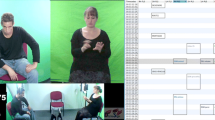Abstract
Misconceptions about the English literacy rates of deaf Americans, the linguistic structure of American Sign Language (ASL), and the suitability of traditional machine translation (MT) technology to ASL have slowed the development of English-to-ASL MT systems for use in accessibility applications. This article traces the progress of a new English-to-ASL MT project targeted to translating texts important for literacy and user-interface applications. These texts include ASL phenomena called “classifier predicates.” Challenges in producing classifier predicates, novel solutions to these challenges, and applications of this technology to the design of user-interfaces accessible to deaf users will be discussed.












Similar content being viewed by others
Abbreviations
- ASL:
-
American Sign Language
- NLP:
-
Natural Language Processing
- MT:
-
Machine Translation
- GUI:
-
Graphical User Interface
References
Bindiganavale, R., Schuler, W., Allbeck, J., Badler, N., Joshi, A., Palmer, M.: Dynamically altering agent behaviors using natural language instructions. In: Proceedings of the 4th International Conference on Autonomous Agents, AGENTS 2000, 3–7 June 2000, Barcelona, Catalonia, Spain (2000)
Coulter G (ed) Phonetics and phonology: current issues in American Sign Language Phonology. Academic, New York (1993)
Elliott, R., Glauert, J., Jennings, V., Kennaway, J.: An overview of the SiGML Notation and SiGML Signing Software System. In: Streiter, O., Vettori, C. (eds.), Proceedings of the Workshop on the Representation and Processing of Signed Languages, 4th International Conference on Language Resources and Evaluation: LREC 2004. 30 May 2004, Lisbon, Portugal, pp. 98–104 (2004)
Holt, J.: Demographic stanford achievement test—8th edition for deaf and hard of hearing students: reading comprehension subgroup results (1991)
Huenerfauth, M.: A survey and critique of American Sign Language natural language generation and machine translation systems. Technical Report MS-CIS-03–32, Computer and Information Science, University of Pennsylvania (2003)
Huenerfauth, M.: A multi-path architecture for machine translation of English text into American Sign Language animation. In: Proceedings of the Student Workshop of the Human Language Technologies conference/North American chapter of the Association for Computational Linguistics annual meeting: HLT/NAACL 2004. Boston, MA, USA (2004)
Huenerfauth, M.: Spatial representation of classifier predicates for machine translation into American Sign Language. In: Proceedings of the Workshop on the Representation and Processing of Signed Languages, 4th International Conference on Language Resources and Evaluation: LREC 2004. Lisbon, Portugal (2004)
Huenerfauth, M.: Spatial and planning models of ASL classifier predicates for machine translation. In: Proceedings of the 10th international conference on theoretical and methodological issues in machine translation: TMI 2004, Baltimore, MD, USA (2004)
Huenerfauth, M.: American Sign Language generation: multimodal NLG with multiple linguistic channels. In: Proceedings of the Association for Computational Linguistics, 43rd Annual Meeting, Student Research Workshop, Ann Arbor, MI, USA (2005)
Huenerfauth, M.: American Sign Language spatial representations for an accessible user-interface. In: Proceedings of the 3rd international conference on universal access in human-computer interaction, Las Vegas, NV, USA (2005)
Huenerfauth, M.: Representing coordination and non-coordination in an American Sign Language Animation. In: Proceedings of the 7th International ACM SIGACCESS Conference on Computers and Accessibility (ASSETS 2005), Baltimore, MD, USA (2005)
Huenerfauth, M: Generating American Sign Language classifier predicates for English-to-ASL Machine Translation, Ph.D. Dissertation, Computer and Information Science, University of Pennsylvania (2006)
Liddell, S.: Grammar gesture and meaning in American Sign Language. Cambridge University Press, Cambridge (2003)
Liddell, S.: Sources of meaning in ASL classifier predicates. In: Emmorey, K. (eds.) Perspectives on classifier constructions in sign languages. Workshop on Classifier Constructions, La Jolla (2003)
Liu, Y.: Interactive reach planning for animated characters using hardware acceleration. Doctoral Dissertation, Computer and Information Science, University of Pennsylvania (2003)
Mitchell, R. How many deaf people are there in the United States. Retrieved June 28, 2004 from Gallaudet Research Institute, Graduate School and Professional Programs, Gallaudet University Web site: http://www.gri.gallaudet.edu/Demographics/deaf-US.php (2004)
Morford, J., MacFarlane, J.: Frequency characteristics of American Sign Language. Sign Lang. Stud. 3(2), 213–225 (2003)
Neidle, C., Kegl, J., MacLaughlin, D., Bahan, B., Lee, R.: The syntax of American Sign Language: functional categories and hierarchical structure. MIT, Cambridge (2000)
Sáfár, É., Marshall, I.: The architecture of an English-Text-to-Sign-Languages translation system. In: Angelova, G. (ed.) Recent advances in natural language processing (RANLP). Tzigov Chark, Bulgaria, pp. 223–228 (2001)
Wideman, C., Sims, M.: Signing avatars. In: Proceedings of the Technology and Persons with Disabilities Conference, March 15–20, 1999, Los Angeles, CA, USA (1998)
Zhao, L., Kipper, K., Schuler, W., Vogler, C., Badler, N., Palmer, M.: A machine translation system from English to American Sign Language. In: Proceedings of the 4th conference of the association for machine translation in the americas on envisioning machine translation in the information future, lecture notes in computer science, 1934, Springer, Heidelberg, London, pp. 54–67 (2000)
Zhao, L., Liu, Y., Badler, N.I.: Applying empirical data on upper torso movement to real-time collision-free reach tasks. In: Proceedings of the SAE Digital Human Modeling Conference, Iowa City (2005)
Acknowledgments
This work was supported by a grant from the US National Science Foundation (Award #0520798 “SGER: Generating Animations of ASL Classifier Predicates,” Universal Access Program, 2005). Software used in this project has been donated by Siemens UGS Tecnomatix and Autodesk. I would like to thank my collaborators at the Center for Human Modeling and Simulation at the University of Pennsylvania: Liming Zhao, Erdan Gu, and Jan Allbeck. I would also like to thank Mitch Marcus, Martha Palmer, and Norman Badler for their guidance and support during this work.
Author information
Authors and Affiliations
Corresponding author
Rights and permissions
About this article
Cite this article
Huenerfauth, M. Generating American Sign Language animation: overcoming misconceptions and technical challenges. Univ Access Inf Soc 6, 419–434 (2008). https://doi.org/10.1007/s10209-007-0095-7
Published:
Issue Date:
DOI: https://doi.org/10.1007/s10209-007-0095-7




